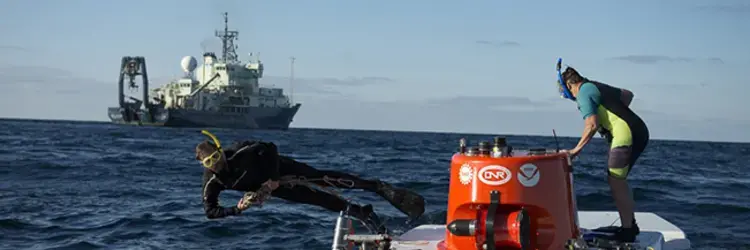2014 Alvin Science Verification Cruise
Table of Contents
- Project Background
- Cruise Objectives
- Cruise Assessment
- Cruise Data and Samples
- Cruise Outreach and Publications
Project Background
Over the past four years, the Human Occupied Vehicle (HOV) Alvin has undergone a suite of enhancements including a new pressure hull with improved visibility and ergonomics, new digital imaging and data acquisition systems, a novel basket that accommodates greater payloads, and numerous improvements to the vehicle's command and control systems. The new pressure sphere has been certified to 6500m. Future upgrades to the submarine's batteries and other major
subsystems will ultimately make this HOV capable of operations at 6500 m.
After successfully completing the DSV Alvin upgrade, the vehicle was put through sea trials and certification. These activities are intended to assure that the submersible is seaworthy and fully functional. However, there are aspects of vehicle operation and performance that are critical to science but not in the purview of the sea trials. Herein we recommended that NSF and other agencies (ONR and NOAA) support a one-‐time "science verification cruise" dedicated to ensuring the readiness
of a broad spectrum of scientific capabilities routinely conducted by the submersible.
It is apparent to DESSC and the broader community that the Alvin upgrade project is functionally equivalent to deploying a new vehicle. As such, a science verification cruise is instrumental to ensuring that the vehicle performs well prior to being used in a fully funded science expedition. It is also worth noting that users will likely be more receptive to requesting DSV Alvin time if they have a better sense of the vehicle's attributes. Moreover, we recommend that this cruise not be viewed as a conventional scientific expedition. Rather, it would provide a means of engaging a community of experienced users to evaluate the key scientific capabilities of the vehicle. This would be achieved through the pursuit of a judiciously selected set of research goals that would simultaneously require a core suite of operational
activities to be carried out.
There is a long long history of partnership between the scientific community and NDSF operations. DSV Alvin's record as the most facile and capable HOV in the world is –in no small part-‐-‐ due to this relationship. The science verification effort recommended here is consistent with that tradition, and exemplifies the role that the broader community can play in refining the operations of the new vehicle.
The National Science Foundation (NSF), the Office of Naval Research (ONR), and the National Oceanic and Atmospheric Administration (NOAA) approved the verification cruise. NSF awarded an EAGER proposal (OCE-‐1360660) to support this endeavor, with Peter Girguis (DESSC chair) as the Principal Investigator.
Cruise Objectives
Cruise Assessment
Cruise Assessment Summary Documents
- Ergonomics
- Basket Attributes
- Instrument Interface and Manipulators
- Video System and Post-Dive Processing
- Video and Stillframe Imaging
- Mapping, Navigation, and Sub Data
- Propulsion, Handling, and Navigation
Cruise Participant Comments
- Comments regarding Alvin Personnel Sphere and Out-of-Sphere Attributes
- Summary Plots of SVC Particpant Rankings
Cruise Data and Samples
Biological Samples:
Animals collected by Alvin were subsampled and preserved for submission to the Ocean Genome Legacy (OGL; http://www.northeastern.edu/marinescience/ogl/). The OGL is a non-profit organization seeking to catalog the DNA of every marine organism, thus serving as a repository for the genetic information contained in this diverse and incredibly important ecosystem. Samples collected during the SVC are in lot number L00093 and correspond to label numbers 1-6 and 8-54 (OGL-assigned sample IDs TBD).
Rock Samples:
AD 4680 Rock 1a
AD 4680 Rock 1b
AD 4682 Rock 1
AD 4682 Rock 2
AD 4682 PC3 0-5cm
AD 4682 PC3 5-10cm
Each sample was placed in a gas-tight mylar bag with filtered bottom seawater, sparged with Ar gas to ensure anoxic conditions, and supplemented with CH4, 2.5 mM H13CO3, and 2 mM 15NH4Cl. They're currently sitting at 4 degrees C in the lab, and will likely be analyzed by Jeffrey Marlow in the coming months.
Core Samples:
Coming soon
In situ Sample Data:
Coming soon.
Processed Multibeam Bathymetry Data:
Coming soon.
Video Data:
Coming soon.
Underway Data - R2R:
The ship-based underway data is available at the R2R website
Cruise Outreach and Publications
Websites
Articles
- (Re)Introducing: The Deep Submergence Vehicle Alvin
- Alvin's Return to Sea
- At 50, Alvin Gets an Extreme Makeover
- Fifty Years of Deep Ocean Exploration with the DSV Alvin
- Researchers Get Back to the Deep
- Welcome to the New Alvin
- Upgraded Alvin Sub Passes Scientific Sea Trials
- Fast Forward: The Alvin Will Make the Ocean More Accessible Than Ever Before
